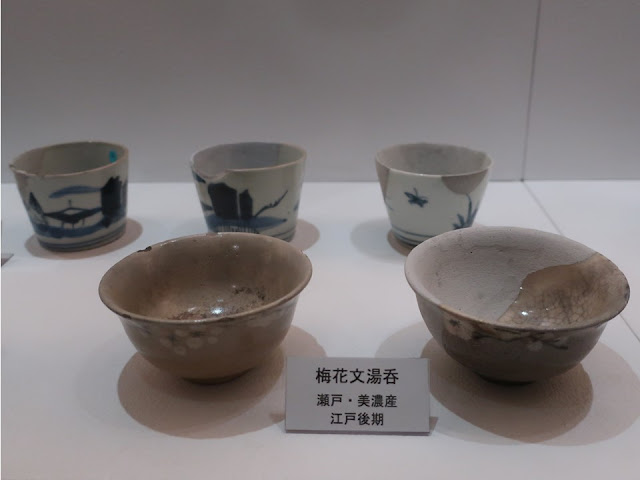Makabe in Ibaraki Prefecture is around 80km northeast of the central Tokyo. “Densho” means “handing down tradition from generation to generation”, and “kan” means “a building”.
There was a castle in the medieval period, and was a local government office (jinya) of the daimyo lord in the following Edo period (1603~1868).
It
is basically a historical museum, hence it’s not easy to find how people enjoyed
their lives. However, some exhibits (cups and spinning tops) gave me a hint how they
enjoyed.
Makabe used to prosper as the trading hub of cottons to Tohoku and
Kanto religions, so 102 buildings remain as registered cultural properties. It
is a peaceful town now.
オシャレな外観。公民館、図書館もあります。
真壁は茨城県桜川市の筑波山麓にあります。かつては、真壁城があり、真壁藩(後には笠間藩)の陣屋がありました。陣屋(その後は町役場)の後に伝承館が建っています。歴史の展示施設ですので、庶民の楽しみは見つけにくかったですが、発掘された盃やコマから皆さんが遊んでいた様子をうかがえます。
町には、102棟の登録文化財の建物が散在しています。かつては、東北や関東への木綿販売の拠点として栄えました。今は静かな町です。
The chronology timeline from the ancient period to the modern period welcomes us.
まずは、通史のコーナー。古代から現代までが年表で説明されています。
Gion festival procession in the town is also shown.
真壁の町を歩く祇園祭の写真もあります。
Until the Kanto Great Earthquake in 1923, a dance float paraded together with other ones. The historical document in 1853 is the agreement among residents about training and execution of the parade. It’s a festival of the community.
The dance float had a stage, and it stopped at several open spaces called “Niwa (garden)”. Then, the stage was assembled and women danced on it to offer to their god. In the modern period, Geisha girls danced. The city officer told that to me. I totally agree that it was a climax of the festival.
関東大震災までは、山車だけでなく、最大の見せ場だった「手踊り屋台」も出たそうです。これは、祭りの段取りを決めた町人達の文書(江戸末期)です。住民主体ですね。
屋台は、山車のようなもので、「庭」と呼ばれる場所で、装置を広げて舞台にし、町内の女性たち、近代には芸者さんたちが、手踊り(花笠踊り)を奉納した、と市の方に教えていただきました
There are stone dealers in Makabe. They carried stones by horse. The horse was working force and it was a big pet at the same time, I think.
真壁には石材屋さんがたくさんあります。かつては、馬で運んでいました。労働力であり、巨大ペットでもあったと思います。
The castle, the jinya office and the town are explained in the largest exhibition room.
メインの展示室は城、陣屋と町の紹介です。
Makabe clan’s emblem on a flag was the wild boar. It is said that the guardian of samurai warriors (Marishiten) rides on it. It looks so strong. (Makabe clan ruled Makabe in the medieval period.)
戦国時代の旗指物(複製)。中世の真壁を支配していた真壁氏は、摩利支天が乗るという猪を旗印にしていました。引かなさそうですねえ。江戸時代になると真壁氏は、佐竹氏とともに秋田に移りました。
The clay cups in the 16th century were excavated from Makabe castle where Makabe clan stationed. Those are for a drinking party. How did they feel and enjoy during the party in the internal war time?
真壁城跡から出土したかわらけ。酒宴の食器です。16世紀の戦乱の時代に多く作られたそうです。戦いと酒、どんな思いでしょうね。
The ceramic cups in the late Edo period (around the 19th century) were excavated from the jinya office. Three cups in behind were for dipping sauce of soba noodle (soba-choko). Only around thirteen samurai officers stationed in the jinya and ruled the area. It’s a peaceful time.
江戸時代の笠間藩陣屋跡で見つかった湯飲みや蕎麦猪口(奥)。普段使いの感じがします。幕末に陣屋に勤めていたのは13人ほどとのこと。少人数ですね。天狗党の乱などに対応できたのでしょうか。
The foot soldier's armor above was lent by the lord, who was Makino clan (daimyo of Kasama-han). The crest on the armor is the one of Makino. It’s not decorative, but it’s light and practical.
足軽胴。貸し出し品で、番号が記されることもありました。笠間藩主牧野氏の家紋が入っています。軽くて動きやすかったそうです。
Toys were also excavated: clay dolls, pigeon shaped whistles, pieces for games and so on.
泥面子、土人形、鳩笛。おもちゃも出てきています。
Makabe town、真壁の街
Buildings which are 102 registered cultural properties dot in a town. There are also more than three hundred of old buildings such as shops, storages and gates, which are not registered.
コンパクトな街に登録文化財の家が点在しています。102棟が登録文化財のほかに、300余棟の見せ蔵・土蔵・門などがあると書いていました。
Hashimoto ryokan (inn), which was built in the early 20th century (Showa period), is registered. And, you can stay there. It’s interesting to walk around and find a favorite building.
橋本旅館さんは昭和初期の旅館建築の文化財です。泊まれます。お気に入りの建物を探すのもいいですね。
The building is a big gate “Nagaya-mon”. It is also registered. There is an udon noodle restaurant “Yoshi” on the right part of the building.
こちらは大きな長屋門。右側がうどん屋「㐂(よし)」さん、文化財です。
Inaka (country style) -udon with tempura is good! And it cost only 600\.
田舎饂飩600円(天ぷら付き)。美味しかった。
Visited
in April, 2021
Official
website: https://www.city.sakuragawa.lg.jp/sp/page/page006835.html (in Japanese), accessed in January,
2022
Previous post (Museum in the neighboring prefecture): Yashio museum、八潮市立資料館
Next post (Museum in the same prefecture): Tsuchiura City Museum、土浦市立博物館















Comments
Post a Comment